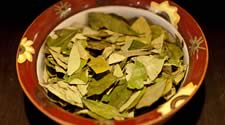 The government of Peru's newly elected President Ollanta Humala announced this week that it is suspending the US-backed coca eradication program in the Upper Huallaga Valley, the only ongoing eradication campaign in the country. According to the UN Office on Drugs and Crime (UNODC), Peru has surpassed Colombia as the world's top coca producer, although Colombia maintains a slight lead in cocaine production.
The government of Peru's newly elected President Ollanta Humala announced this week that it is suspending the US-backed coca eradication program in the Upper Huallaga Valley, the only ongoing eradication campaign in the country. According to the UN Office on Drugs and Crime (UNODC), Peru has surpassed Colombia as the world's top coca producer, although Colombia maintains a slight lead in cocaine production.
The Upper Huallaga is Peru's second largest coca-growing area after the Apurímac-Ene River Valley (VRAE). Far more coca is produced in the VRAE, but an eradication campaign there was been put off while the army battles a remnant of the Shining Path insurgency that survives there.
Humala's new head of the National Commission for the Development of Life Without Drugs (DEVIDA), Ricardo Soberón, told reporters Aug. 17 that the program is being suspended so the government can "evaluate the policies." Soberón—a policy analyst with the Transnational Institute who has been a critic of eradication and an advocate of coca "reduction"—added that the Humala administration is in the process of renegotiating anti-drug agreements with the US. "In every country—in Afghanistan, in Colombia, in Bolivia, in Mexico—it is normal to have these pauses to do the necessary evaluation of what has happened, to correct mistakes," he said.
According to the UNODC, Peru's coca production increased 2% in 2010, with 150,000 acres now under cultivation. Coca cultivation for traditional and medicinal uses is legal in designated areas of Cuzco region, with the government's National Coca Company (ENACO) maintaining a monopoly on distribution. The Upper Huallaga Valley was the top illegal cultivation region when the eradication campaign was first undertaken in 1994, and also then the most significant Shining Path stronghold.
Humala campaigned on a platform that included decriminalizing unregistered coca growers. At a campaign stop in May, he promised an audience in the Huallaga Valley town of Tingo Maria that he would re-evaluate the government's eradication program in the area. The Huallaga Valley is said to have some 5,000 acres under cultivation. The eradication campaign involves about 900 workers in the valley, and includes crop substitution programs.
The suspension was ordered Aug. 16 by Interior Minister Oscar Valdes, who said the suspension was implemented to "complete evaluations and reorient means." He assured that the eradication would be resumed in a matter of weeks, stating: "In his message to the nation, President Ollanta Humala has been very clear: The government will not permit the extension of illicit crops and will work decisively to reduce them."
The US State Department said: "We do not believe that the temporary suspension of eradication this week represents a permanent shift in the Peruvian government's counternarcotics policy." The statement said Peruvian government officials "at the highest levels" assured the US embassy in Lima "of their intention to continue close collaboration in the fight against narcotics trafficking and criminality, and to work together to continue to reduce the cultivation of illegal coca in Peru." US Ambassador Rose Likins said she was awaiting further information on the decision, but that it was "natural" that a new government would want to re-assess its programs.
Opposition politicians in Peru have been more critical of the suspension. Media commentator and former interior minister Fernando Rospigliosi charged Humala with betraying his pledge upon taking office to continue with eradication. "It says to coca producers and guerrillas, 'Go ahead, plant your coca, nothing will happen'," he said. (Drug War Chronicle, Aug. 19; LAT, AlJazeera, InSight Crime, Aug. 18; El Comercio, BBC News, Aug. 17)
A low-level war continues in the VRAE. One suspected Shining Path guerilla was killed and two others captured in a clash at the village of Kepashiato, Ayacucho region, on July 28. The army reported confiscating a pistol, three two-way radios, and two backpacks full of cocaine chlorhydrate. (La Republica, July 30; EFE, July 29)
Peru has challenged UNODC's findings that the country is overtaking Colombia as the continent's top coca producers, and resisted international pressure to ban coca cultivation altogether. The government has also stood up to similar pressure to undertake an eradication campaign in the VRAE.
From World War 4 Report, Aug. 20







Recent comments
3 weeks 2 days ago
7 weeks 1 day ago
11 weeks 1 day ago
11 weeks 6 days ago
21 weeks 6 days ago
26 weeks 1 hour ago
27 weeks 12 hours ago
27 weeks 15 hours ago
48 weeks 1 day ago
1 year 1 day ago